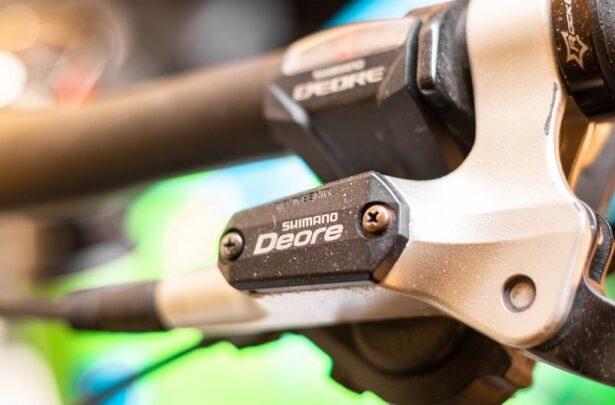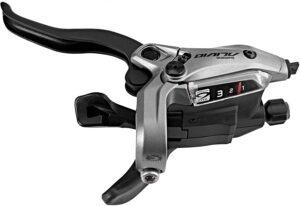Introduction
Shimano have many different lines of components, mountain bike and otherwise, and two of these are their ‘Deore’ and ‘Alivio’ lines. Shimano Alivio is a budget friendly, entry level one, two or three by nine gearset that includes quick release hubs and all three of the main types of brakes: v-brakes, mechanical disc brakes and hydraulic disc brakes.
Shimano Deore is a slightly more expensive, trail-oriented line of components that include al1x10, 2×10, 1×11, 2×11 and 1×12 gearsets with many other features that the Alivio line does not have such as wheel sets and dropper levers.
Shimano Alivio Overview
Generally, Shimano Alivio is more oriented for the weekend rider, with a slighter older specced bike who wants a freshen-up but doesn’t want to break the bank. This can be seen by their less aggressive v-brake options and older-fashioned (by today’s standards!) nine speed gearsets.
The use of a front derailleur on two out of three of their gearsets may put off the more avid biker and the very idea of v-brakes may send shivers down some riders’ spines, but the truth is that for most people who ride casually or for exercise, it’s just enough.
Shimano Deore Overview
On the other hand, Shimano Deore uses more modern ten, eleven and 12 speed gearsets. The average mountain biker will be using a 1x system by now for its advantages in chain retention, weight savings and simplicity.
Shimano Deore is a great option for a relatively inexpensive-but-modern gearset for those riders wanting to move onto the newer gear combos.
Deore also includes more modern and more secure thru-axles as well as the classic quick release. Thru-axles are far more secure, being tightened by an allen bolt rather than a hand screw, and are also considered to be stronger due to being so much thicker than their quick-release counterparts.
This could be a necessity more than an option for many bikers since your axle fitting relies on your fork or frame using either one.
Gearsets
Shimano Alivio offers a 2×9 or 3×9 gearset with a full crankset, front and rear derailleur. The 2x system is, nowadays, rather dated, but it is perfect for a less serious mountain biker who doesn’t need the extra chain retention of a 1x system and who wants a large range of gears.
Shimano Deore has a much wider range of gearsets with 1x 10,11 and 12 as well as a 2×10 and 11 option. These 2 by systems have many more options for staying in the perfect cadence, so can be seen as an upgrade over Alivio.
The 1x systems will offer a broadly equal range, but with less overall options. While some may see this as a downgrade, 1x systems often offer a far better chain retention since the front sprocket isn’t designed for the chain to come off in any scenario.
Brakes
 Alivio again has a more dated system, offering 3-finger brake levers for both their mechanical and hydraulic options. For a trail rider, this simply isn’t appropriate as on the trails, 1-finger braking is essential to maintaining grip on the bars throughout braking.
Alivio again has a more dated system, offering 3-finger brake levers for both their mechanical and hydraulic options. For a trail rider, this simply isn’t appropriate as on the trails, 1-finger braking is essential to maintaining grip on the bars throughout braking.
Furthermore, the mechanical options likely wouldn’t cut it for most trail riders either. Deore on the other hand has many different options of hydraulic-only 2-pot and 4-pot brake calipers.
For trail riding, hydraulic brakes offer a massive advantage in braking power and consistency over mechanical options.
Also, Deore uses a more trail-oriented 1-finger brake lever designed not to allow 3 finger braking, which is far better for trail use and will be easier to set up properly.
Wheels
Shimano Alivio does not include wheelsets, so can’t be accurately compared to Deore, however Deore offers a wide selection of 27.5” and 29” wheels. Some of the higher end wheels (in the M6100 line in particular) offer tubeless ready wheels.
Tubeless wheels allow for lower pressures and better puncture resistance so this option is a no-brainer for the more serious mountain-biker (not to say that they are necessary by any means.) All of the Deore wheels utilise thru-axles, so again they are shown to be more appropriate to the more serious mountain biker.
Pedals

Alivio does not supply any kind of flat pedal like Deore does. Shimano Deore offers an aggressive, wide flat pedal with long screw pins for maximum grip.
Both lines offer SPD pedals, with Deore having a wider selection of styles. Alivio make a smaller and a larger footprint pedal whereas Deore supply two larger-footprint pedals.

Under the Deore name is also a trail-specific SPD pedal which offers a more aggressive looking design with a wide platform to offer better support and grip on the trails.
As someone who rides flat pedals, I like the option to still run flat pedals.
Deore I-Spec EV
Shimano Deore boasts I-spec EV on many of the cockpit components. As described by Shimano: “I-SPEC EV increases brake lever rigidity by moving the lever inwards”. This pulling in of the brake lever means that the base of the lever forms an extra point of contact with the bar, meaning that flex through the lever itself is reduced.
Also, the I-spec EV system provides modular brake, gear and dropper seat post levers which, according to Shimano, can accommodate a much wider range of adjustment for many more riding styles than other systems.
Bottom Brackets

Alivio bottom brackets are older, square type bottom brackets (which means that the spindles have square ends) and actually use Deore bottom brackets for newer standard spindles and cranksets.
Deore, on the other hand uses 68/73 press fit or threaded bottom brackets for all of their cranksets. These differences are again born more out of necessity than choice as on cheaper (or older) bikes, a square type bottom bracket may be required and the newer styles may simply be incompatible.
Verdict
Shimano Alivio is targeted at the casual rider such as family groups and people who ride simply to get outdoors, not to ride trails and jumps. For this purpose, Shimano Alivio is incredible, offering brand new components to freshen up older spec bikes without breaking the bank. The parts are cheap and are designed to be affordable.
Shimano Deore, on the other hand, is targeted far more to the average entry-level to intermediate rider. The line-up includes parts that you could expect from far more expensive lines, but the line caters for all disciplines of riding.
This does mean that the parts won’t be as specialized as a more expensive line, but the parts do their job very well. It caters to almost any bike and riding style and can bring the more premium, high-end feel of the new standards whilst costing far less.
I think that it’s obvious to see that the lines are very different, with different uses in mind. By this logic when choosing between the two you have to consider a final few things: which is more appropriate for my riding style? Which will fit my bike? Which fits my budget best?
This more advanced technology on the Deore line-up cements it as a higher range line than the Alivio counterpart.

Tim Hunt is an amateur mountain biker from the Surrey Hills area of England. He has been riding and building for many years in and around the Surrey Hills and loves fast and techy descents!



I noticed that the new trek fx3 has alivio while the older model with discs has the deore. Difference in price, but overall?